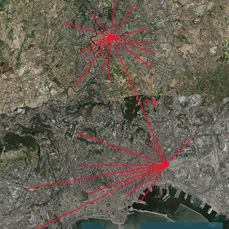High Speed Train, New Urban Proximity and Macro-Functional Urban Systems Generation
Abstract
The new connections, that high speed railway allows to activate among the metropolitan systems, seem to be able to give life to new urban macro-structures for which the transfer time, among the main poles of the railway segment, it becomes comparable to an inside moving into the city and therefore considered as a interfunctional mobility. The tunnel effect generated by the high speed connection seems to be able to allow a new temporal and functional joint among the metropolitan systems consequently supporting the possibility, for the users, to move themselves among the different urban functions belonging to the different cities. The birth of these urban aggregations seems to conduct toward new megalopolis, which we can define for the first time with the term: joint-city. For this new metropolitan settlement it appears of great interest to investigate the constitutive peculiarities, the systemic articulation, its relationl structures, the evolutionary sceneries, and so on. When new connections are created among functional systems, previously separated, supported by the realization of physical infrastructures (like the HST) it is possible to envisage the birth of new multi-urban organizations, of new macrofunctional urban systems, of joint-cities, whose characteristics and articulations are all to deepen and they offer an interesting mind field to the town planning research.Downloads

Copyright (c) 2014 Tema. Journal of Land Use, Mobility and Environment

This work is licensed under a Creative Commons Attribution 4.0 International License.
Authors who publish in this journal agree to the following:
1. Authors retain the rights to their work and give in to the journal the right of first publication of the work simultaneously licensed under a Creative Commons License - Attribution that allows others to share the work indicating the authorship and the initial publication in this journal.
2. Authors can adhere to other agreements of non-exclusive license for the distribution of the published version of the work (ex. To deposit it in an institutional repository or to publish it in a monography), provided to indicate that the document was first published in this journal.
3. Authors can distribute their work online (ex. In institutional repositories or in their website) prior to and during the submission process, as it can lead to productive exchanges and it can increase the quotations of the published work (See The Effect of Open Access)
